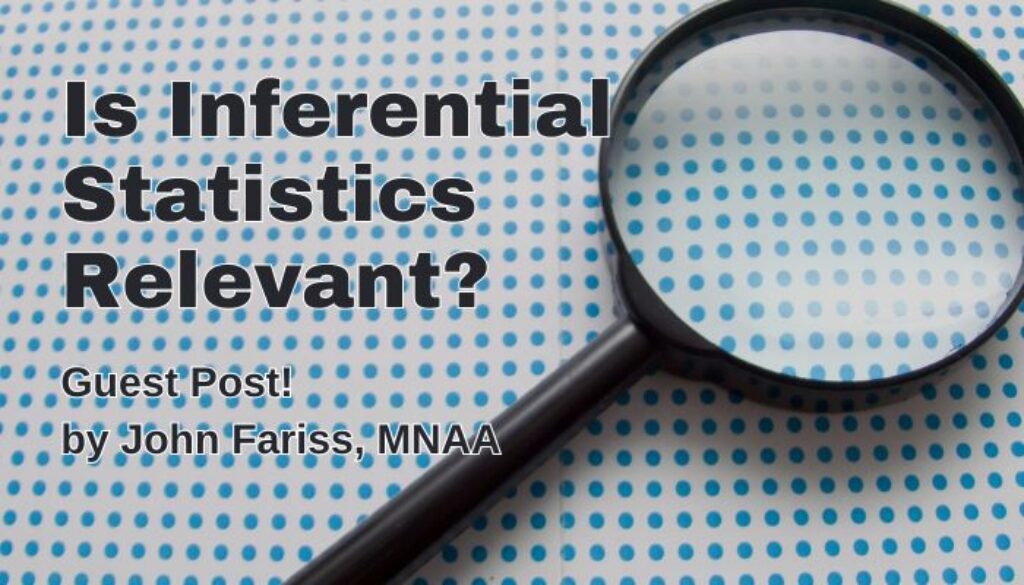Inferential statistics, at its core, is concerned with making inferences about a population based on a sample drawn from that population. It involves analyzing sample data to draw conclusions about the broader population because the broader population is either too large to analyze, unknown, or hypothetical. While invaluable in many scientific disciplines and research contexts, its applicability in residential real estate appraisal warrants scrutiny.
Editor’s Note: Guest Post from John Fariss, MNAA. John is the owner of Fariss Appraisal Services located in Bakersfield, CA. He is a frequent contributor to George Dell’s Valuemetrics.Info classes and an active Moderator for the Community of Asset Analysts©. Recently John wrote a new extensive article for The Asset Analyst Report© (TAAR) entitled, “Is is a Market or a Population”. For more information on The Asset Analyst Report and to receive discounts on upcoming classes, Subscribe to TAAR here.
In the world of residential real estate appraisal, the quest for precision and reproducibility often leads appraisers down the path of statistical analysis. Yet, amidst the sea of data and methodologies, one question looms large: Is inferential statistics truly relevant in the context of residential real estate valuation?
The Unique Dynamics of Residential Real Estate
Residential real estate is a complex market where individual homes are as diverse as the people who live in them. Inferential statistics works better with controlled or homogeneous populations. Residential real estate valuation analyzes markets, and the residential housing market has a vast array of factors that defy the assumptions of inferential statistics.
Properties, even in the same neighborhood, vary in terms of location, size, floorplan, condition, amenities, and countless other attributes, making it challenging to find truly comparable properties. Moreover, the market is influenced by subjective factors such as aesthetics, personal preferences, and emotional attachments, which are difficult to quantify using traditional statistical methods. How do we objectively quantify transactions that are frequently subjectively motivated?
The Case for Data Science
In residential real estate appraisal, competitive sales analysis reigns supreme as the primary, but not only, method for determining property values. Relying on the principle of substitution, we can reduce our initial Assignment Data Frame©, or ADF©, to a competitive market segment©. How do we do this?
While we can use statistical techniques such as regression analysis and adjustment modeling, it does not necessitate the use of inferential statistics. Instead, we focus on descriptive statistics in exploratory data analysis to identify patterns, summarize and interpret the characteristics of competitive properties, and reduce to the CMS© without making inferences about the broader ADF©.
Where data science really diverts from inferential statistics is in its multidisciplinary tools and the role of a domain expert. In our case, the appraiser is the domain expert. And, our expert judgment often beats out statistical sophistication. It is our knowledge, experience, and intuition that enable us to assess the unique features of each property and the local market. This qualitative aspect of appraisal goes beyond the methods of inferential statistics, using critical thinking, relying on judgment calls and professional expertise rather than mathematical models.
Evidence Based Valuation: A Holistic Approach to Valuation
While inferential statistics undoubtedly has its place in certain domains, its relevance in residential real estate appraisal is debatable. The unique dynamics of Assignment Data Frames© and Competitive Market Segments©, coupled with the limitations of sales analysis and the role of expert judgment, indicate that Evidence Based Valuation© is more pertinent for determining property values.
In the quest for precision and accuracy, we must adopt a holistic approach to valuation that integrates data science with qualitative judgment. Inferential statistics once had its place in valuation, but it is no longer appropriate for most applications. We now have access to the data, we have the computing power and memory, and we have the software. We can use all the data. We can use complete market segments. And with these, we can be better residential appraisers.
Don’t take a sample. Analyze the whole competing market segment©.
